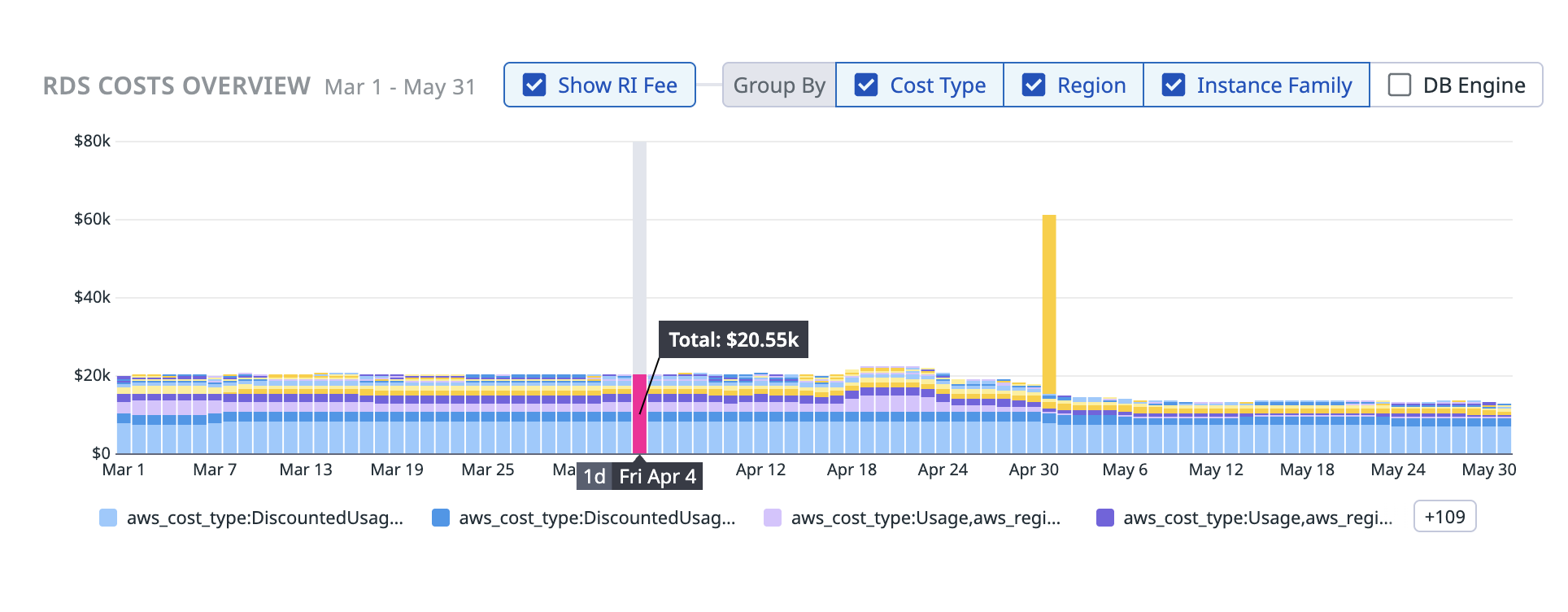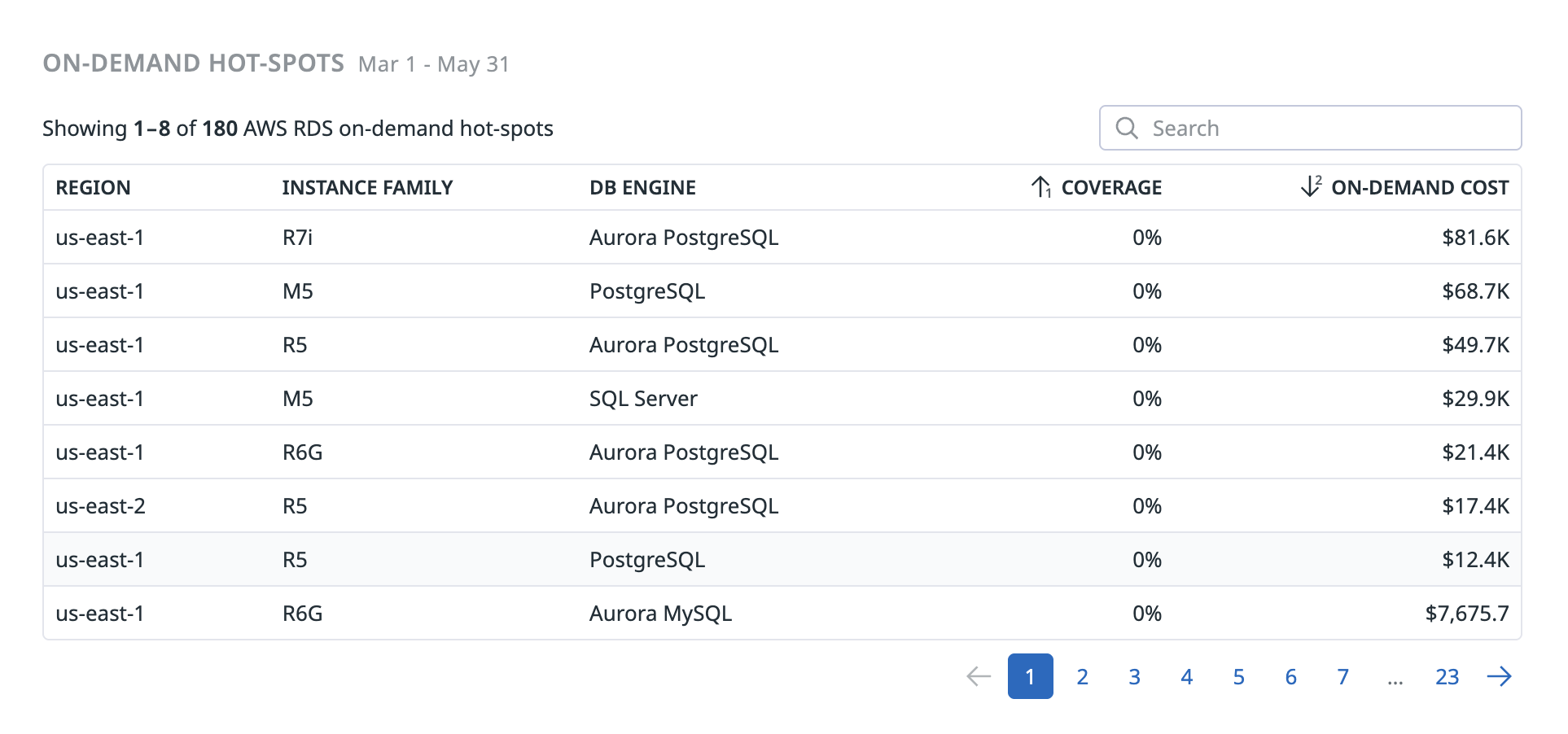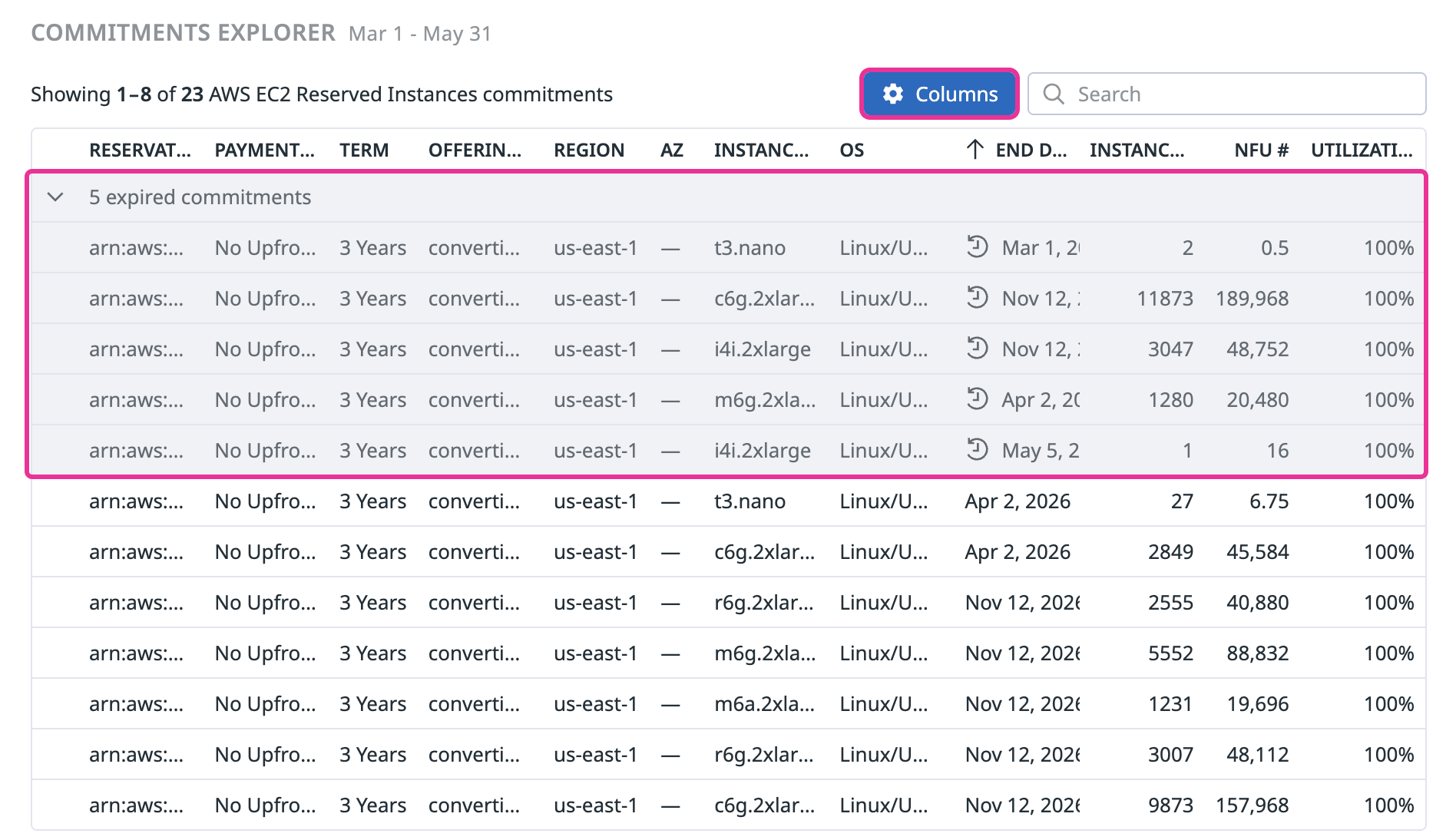- Esenciales
- Empezando
- Datadog
- Sitio web de Datadog
- DevSecOps
- Serverless para Lambda AWS
- Agent
- Integraciones
- Contenedores
- Dashboards
- Monitores
- Logs
- Rastreo de APM
- Generador de perfiles
- Etiquetas (tags)
- API
- Catálogo de servicios
- Session Replay
- Continuous Testing
- Monitorización Synthetic
- Gestión de incidencias
- Monitorización de bases de datos
- Cloud Security Management
- Cloud SIEM
- Application Security Management
- Workflow Automation
- CI Visibility
- Test Visibility
- Intelligent Test Runner
- Análisis de código
- Centro de aprendizaje
- Compatibilidad
- Glosario
- Atributos estándar
- Guías
- Agent
- Uso básico del Agent
- Arquitectura
- IoT
- Plataformas compatibles
- Recopilación de logs
- Configuración
- Configuración remota
- Automatización de flotas
- Solucionar problemas
- Detección de nombres de host en contenedores
- Modo de depuración
- Flare del Agent
- Estado del check del Agent
- Problemas de NTP
- Problemas de permisos
- Problemas de integraciones
- Problemas del sitio
- Problemas de Autodiscovery
- Problemas de contenedores de Windows
- Configuración del tiempo de ejecución del Agent
- Consumo elevado de memoria o CPU
- Guías
- Seguridad de datos
- Integraciones
- OpenTelemetry
- Desarrolladores
- Autorización
- DogStatsD
- Checks personalizados
- Integraciones
- Crear una integración basada en el Agent
- Crear una integración API
- Crear un pipeline de logs
- Referencia de activos de integración
- Crear una oferta de mercado
- Crear un cuadro
- Crear un dashboard de integración
- Crear un monitor recomendado
- Crear una regla de detección Cloud SIEM
- OAuth para integraciones
- Instalar la herramienta de desarrollo de integraciones del Agente
- Checks de servicio
- Complementos de IDE
- Comunidad
- Guías
- Administrator's Guide
- API
- Aplicación móvil de Datadog
- CoScreen
- Cloudcraft
- En la aplicación
- Dashboards
- Notebooks
- Editor DDSQL
- Hojas
- Monitores y alertas
- Infraestructura
- Métricas
- Watchdog
- Bits AI
- Catálogo de servicios
- Catálogo de APIs
- Error Tracking
- Gestión de servicios
- Objetivos de nivel de servicio (SLOs)
- Gestión de incidentes
- De guardia
- Gestión de eventos
- Gestión de casos
- Workflow Automation
- App Builder
- Infraestructura
- Universal Service Monitoring
- Contenedores
- Serverless
- Monitorización de red
- Coste de la nube
- Rendimiento de las aplicaciones
- APM
- Términos y conceptos de APM
- Instrumentación de aplicación
- Recopilación de métricas de APM
- Configuración de pipelines de trazas
- Correlacionar trazas (traces) y otros datos de telemetría
- Trace Explorer
- Observabilidad del servicio
- Instrumentación dinámica
- Error Tracking
- Seguridad de los datos
- Guías
- Solucionar problemas
- Continuous Profiler
- Database Monitoring
- Gastos generales de integración del Agent
- Arquitecturas de configuración
- Configuración de Postgres
- Configuración de MySQL
- Configuración de SQL Server
- Configuración de Oracle
- Configuración de MongoDB
- Conexión de DBM y trazas
- Datos recopilados
- Explorar hosts de bases de datos
- Explorar métricas de consultas
- Explorar ejemplos de consulta
- Solucionar problemas
- Guías
- Data Streams Monitoring
- Data Jobs Monitoring
- Experiencia digital
- Real User Monitoring
- Monitorización del navegador
- Configuración
- Configuración avanzada
- Datos recopilados
- Monitorización del rendimiento de páginas
- Monitorización de signos vitales de rendimiento
- Monitorización del rendimiento de recursos
- Recopilación de errores del navegador
- Rastrear las acciones de los usuarios
- Señales de frustración
- Error Tracking
- Solucionar problemas
- Monitorización de móviles y TV
- Plataforma
- Session Replay
- Exploración de datos de RUM
- Feature Flag Tracking
- Error Tracking
- Guías
- Seguridad de los datos
- Monitorización del navegador
- Análisis de productos
- Pruebas y monitorización de Synthetics
- Continuous Testing
- Entrega de software
- CI Visibility
- CD Visibility
- Test Visibility
- Configuración
- Tests en contenedores
- Búsqueda y gestión
- Explorador
- Monitores
- Flujos de trabajo de desarrolladores
- Cobertura de código
- Instrumentar tests de navegador con RUM
- Instrumentar tests de Swift con RUM
- Detección temprana de defectos
- Reintentos automáticos de tests
- Correlacionar logs y tests
- Guías
- Solucionar problemas
- Intelligent Test Runner
- Code Analysis
- Quality Gates
- Métricas de DORA
- Seguridad
- Información general de seguridad
- Cloud SIEM
- Cloud Security Management
- Application Security Management
- Observabilidad de la IA
- Log Management
- Observability Pipelines
- Gestión de logs
- Administración
- Gestión de cuentas
- Seguridad de los datos
- Sensitive Data Scanner
- Ayuda
Commitment Programs
This page is not yet available in Spanish. We are working on its translation.
If you have any questions or feedback about our current translation project, feel free to reach out to us!
If you have any questions or feedback about our current translation project, feel free to reach out to us!
CCM Commitment Programs supports Amazon RDS Reserved Instances and Amazon EC2 Reserved Instances.
Overview
Cloud providers offer commitment-based discount programs (like A type of cloud commitment where you reserve capacity for a specific instance type and term, usually at a discounted rate. and Flexible cloud discount programs that provide lower prices in exchange for a commitment to a consistent amount of usage (measured in $/hour) over a term. ) to help you save on predictable usage. Datadog’s Commitment Programs feature helps you monitor, optimize, and maximize the value of these discounts across your cloud environments.
With this feature, you can:
- Track and address unused or underused commitments.
- Target high Cloud resources billed at standard rates, without any commitment or discount program. spend with additional commitments.
- Monitor expirations and plan timely renewals.
- Reduce waste by right-sizing or reallocating commitments.
This page describes the information available on the Commitment Programs page so you can better understand how your commitments are being utilized and take the necessary action.
Getting started
Navigate the Commitment Programs page and take action.
Access the Commitment Programs page in Cloud Cost Management by navigating to: Cloud Cost > Planning > Commitment Programs.
Review the KPIs in the commitments overview section.
Use filters to focus on specific accounts, regions, or services.
Explore the costs overview to analyze utilization, coverage, and expiring commitments.
Review expiration dates and renewal recommendations in the Commitments Explorer.
Take action. Based on the insights from the Commitment Programs page, you can:
- Adjust workloads to make better use of your existing commitments and avoid extra on-demand charges.
- Update commitments by buying or changing them based on your usage data.
- Plan renewals by renewing or retiring commitments before they expire.
- Optimize spend by using Datadog’s tips to save more and reduce waste.
Commitments overview
The commitments overview section is where you can review the following Key Performance Indicators (KPI) for your cloud providers and services.
Effective Savings Rate (ESR): The percentage of cost savings achieved by your discount programs compared to on-demand prices, factoring in both utilized and underutilized commitments.
Example: Coverage is 90% but ESR is 65%—you may have underutilized commitments dragging down your savings.
Absolute Savings: The total dollar amount saved by using commitment programs versus on-demand rates.
Example: You spent $10,000 on cloud services last month, but would have spent $14,000 at on-demand rates, so your absolute savings is $4,000.
Coverage: The proportion of your usage protected by a discount program (such as Reserved Instances, Savings Plans, or Agreements with cloud providers to use a certain amount of resources for a discounted rate over a set period. ).
Example: If EC2 compute coverage is 50%, half of your usage is on-demand. Increasing coverage to 80% could reduce your bill.
Utilization: How much of your purchased commitments are actually being used.
Example: If a 1-year GCP Committed Use Contract is only 70% utilized, 30% is going unused and may need adjustment.
Costs overview
The Costs Overview section provides a comprehensive summary of your spending on commitment programs. It helps you understand where your cloud costs are going and how your commitments are impacting your overall spend. In this section, you can do the following:
- Show RI fee: Toggle the display of RI fees to see the direct costs associated with your reserved capacity, making it easier to distinguish between on-demand and commitment-based spending.
- Group By options: Organize and analyze your costs by different dimensions, such as cost type, region, instance family, or database engine. This allows you to:
- Identify which regions or services are driving the most spend
- Compare costs across different instance families or database engines
- Pinpoint areas where you may benefit from additional commitments or need to adjust your strategy
- Total commitment spend: View how much you are spending on reserved capacity versus on-demand, helping you assess the effectiveness of your commitment strategy.
- Savings breakdown: See the savings achieved through commitment programs compared to on-demand pricing, giving you a clear picture of the financial impact of your discount programs.
- Service-level details: Analyze costs by service, region, or account to identify where your commitment programs are delivering the most value and where there may be opportunities for further optimization.
By leveraging the Costs Overview section, you can make informed decisions about purchasing, renewing, or adjusting your commitments to maximize savings and minimize waste in your cloud environment.
On-demand hot-spots
The On-demand hot-spots section highlights areas where you are incurring high on-demand costs, which may indicate opportunities to purchase additional commitments.
Use this section to:
- Identify high on-demand usage: Quickly spot services, regions, or accounts with significant on-demand spend.
- Estimate potential savings: See how much you could save by converting on-demand usage to commitment-based pricing.
- Take action: Use these insights to adjust workloads or purchase new commitments to reduce future on-demand costs.
Commitments Explorer
The Commitments Explorer provides a detailed, interactive table of all your cloud commitment contracts, such as database reserved instances. It allows you to browse, search, filter, and sort your commitments by key attributes so you can track your inventory, monitor expiration dates, and identify opportunities to optimize usage and savings.
- You can customize the table view by showing or hiding columns like Start Date, Multi-AZ, and NFU # (where applicable) to focus on the information most relevant to your needs.
- The table also highlights commitments that are expiring soon.
| Column | Description |
|---|---|
| Reservation ARN | The unique Amazon Resource Name identifying the Reserved Instance commitment. |
| Payment model | The payment option selected for the Reserved Instance (such as No Upfront, Partial Upfront, All Upfront). |
| Term | The duration of the Reserved Instance commitment (such as 1 Year, 3 Years). |
| Region | The region where the Reserved Instance is applied. |
| Instance type | The type and size of the database instance covered by the commitment (like db.r6g.large). |
| DB engine | The database engine used by the instance (such as PostgreSQL, MySQL, SQL Server). |
| Start date | The date when the Reserved Instance term begins. |
| End date | The date when the Reserved Instance term ends. |
| Multi-AZ | Indicates whether the Reserved Instance covers a multiple availability zone deployment (Yes/No). |
| Instance # | The number of database instances covered by the Reserved Instance. |
| NFU # | The number of normalized units (NFUs) covered, which standardizes instance sizes for comparison. |
| Utilization | The percentage of the Reserved Instance that is actually being used during the selected period. |
Example use cases
Identify underutilized commitments
Scenario
You notice that your Effective Savings Rate (ESR) is lower than expected, even though your coverage is high.
How to use commitment programs
- Go to the Commitments Overview and check the utilization KPI.
- Filter by account, region, or instance family to pinpoint which commitments are underutilized.
- Take action by reallocating workloads to use these commitments more effectively, or consider modifying or selling unused commitments if your cloud provider allows.
Plan for expiring commitments
Scenario
Several Reserved Instances are set to expire next month, and you want to avoid unexpected on-demand charges.
How to use Commitment Programs
- In the Costs Overview, review the list of commitments and their expiration dates.
- Use the filters to focus on soon-to-expire commitments.
- Plan renewals or replacements in advance to maintain coverage and maximize savings.
Targeting high on-demand spend
Scenario
Your cloud bill shows a spike in on-demand usage in a specific region.
How to use Commitment Programs
- Use the On-demand Hot-Spots section to identify which services, regions, or accounts are incurring high on-demand costs.
- Estimate potential savings by converting this usage to commitment-based pricing.
- Purchase new commitments or adjust workloads to reduce future on-demand costs.
Optimize commitment strategy across multiple accounts
Scenario
You manage multiple cloud accounts and want to ensure all are benefiting from commitment programs.
How to use Commitment Programs
- Use the filters to compare KPIs across different accounts.
- Identify accounts with low coverage or utilization.
- Adjust your purchasing strategy to allocate commitments where they have the most impact.
Analyze savings breakdown
Scenario
You want to report on the financial impact of your commitment programs to stakeholders.
How to use Commitment Programs
- In the Costs Overview, view the savings breakdown compared to on-demand pricing.
- Group costs by service, region, or account to highlight where the most savings are achieved.
- Export or screenshot the data for use in reports or presentations.
Further Reading
Más enlaces, artículos y documentación útiles:





